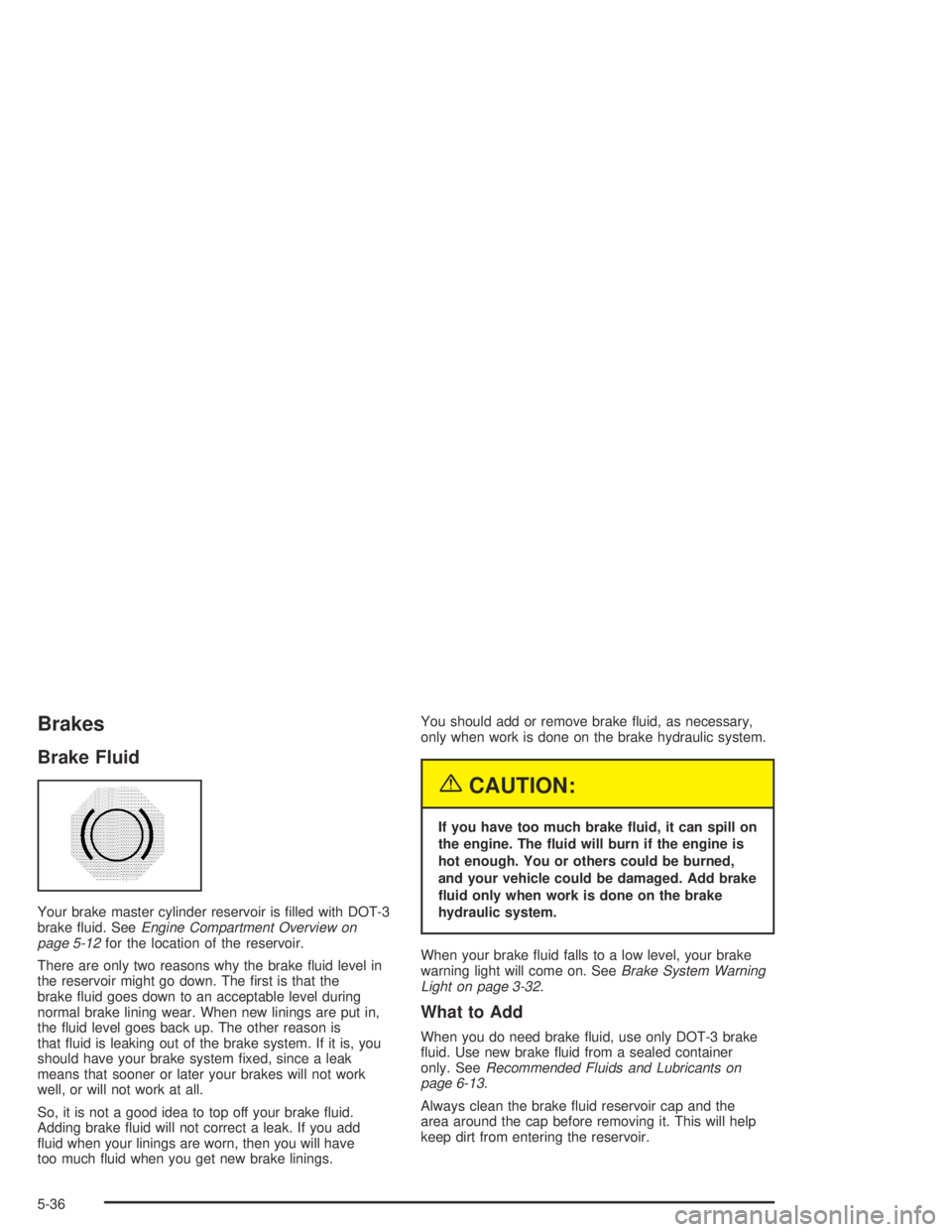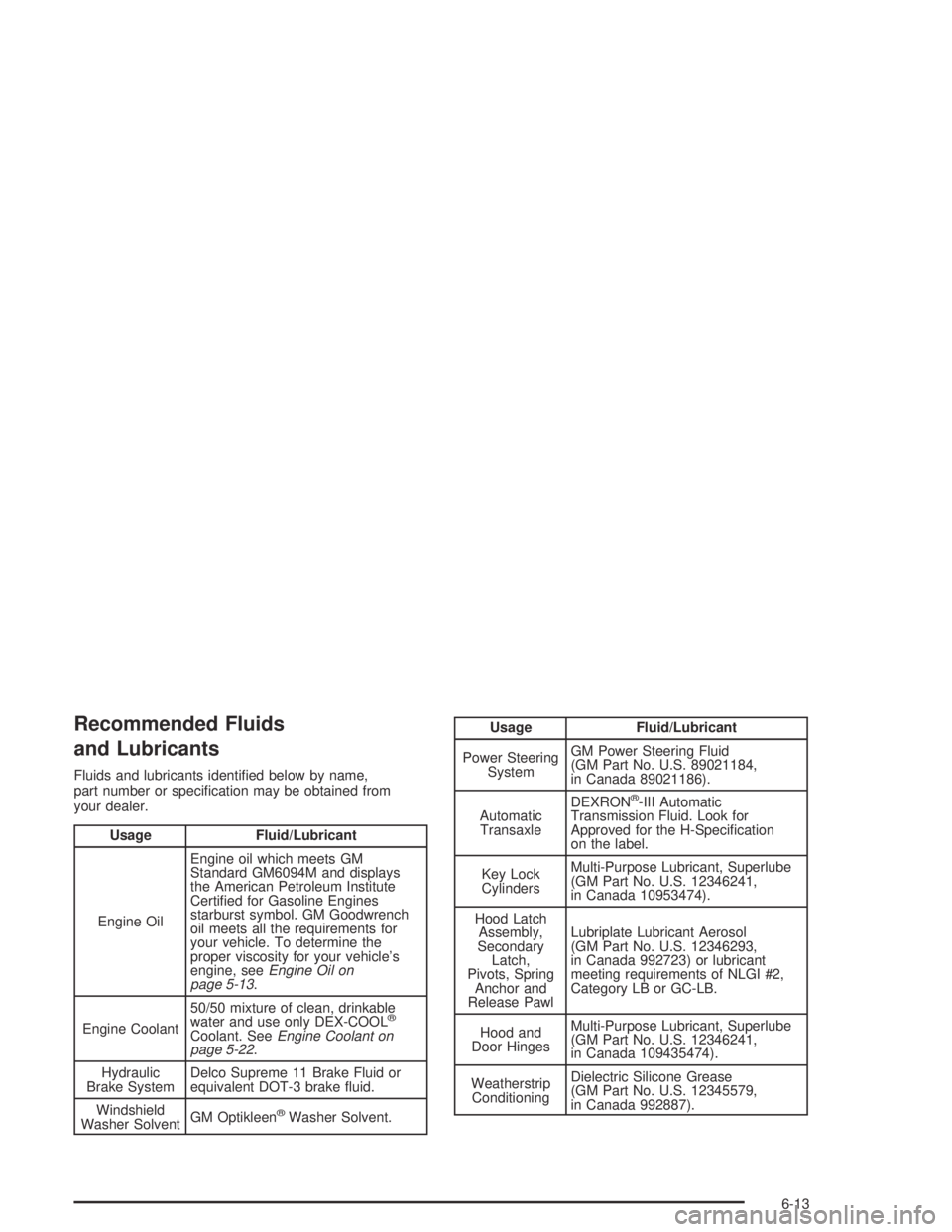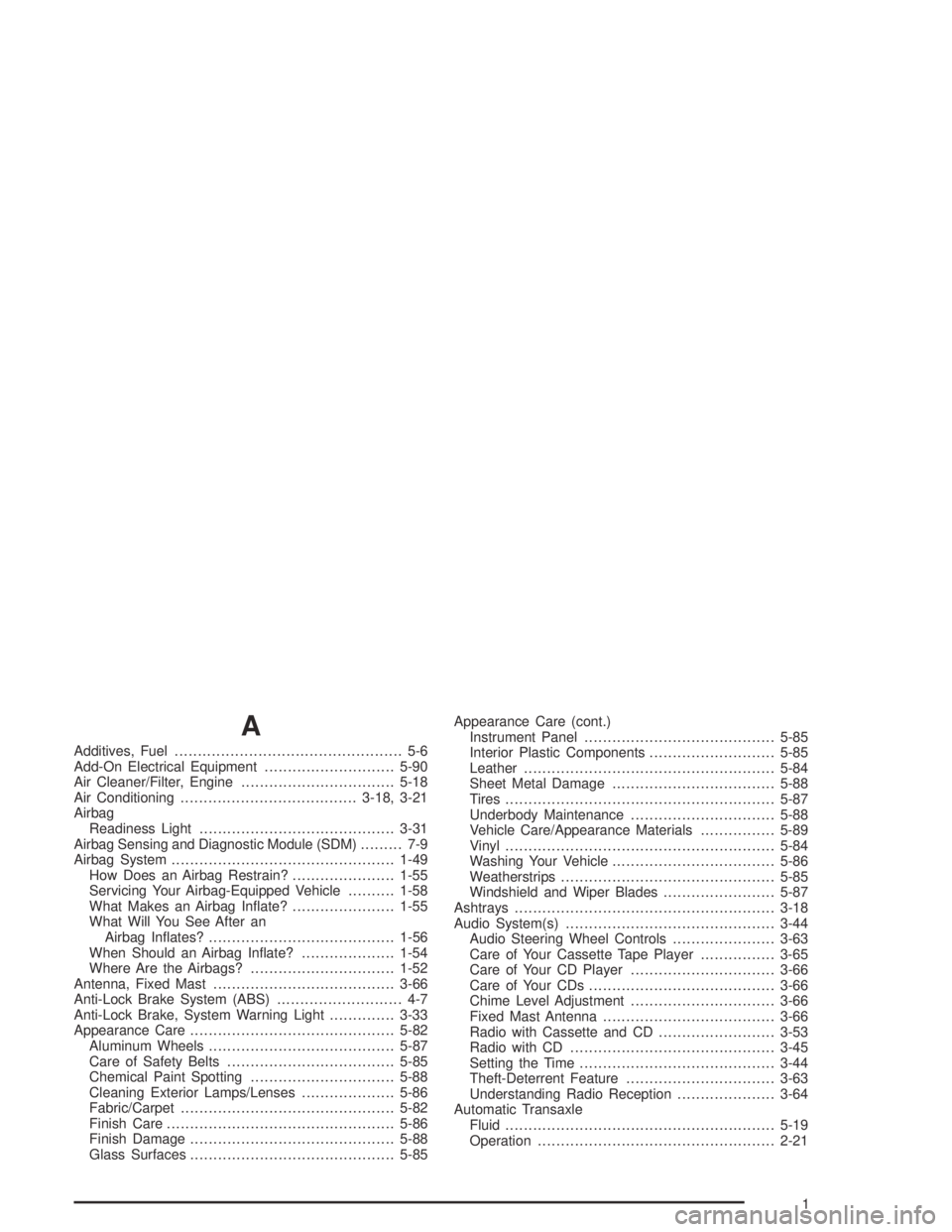2005 BUICK CENTURY brake fluid
[x] Cancel search: brake fluidPage 211 of 348

Service............................................................5-3
Doing Your Own Service Work.........................5-4
Adding Equipment to the Outside
of Your Vehicle...........................................5-5
Fuel................................................................5-5
Gasoline Octane............................................5-5
Gasoline Speci�cations....................................5-5
California Fuel...............................................5-6
Additives.......................................................5-6
Fuels in Foreign Countries...............................5-7
Filling Your Tank............................................5-8
Filling a Portable Fuel Container.....................5-10
Checking Things Under the Hood....................5-10
Hood Release..............................................5-11
Engine Compartment Overview.......................5-12
Engine Oil...................................................5-13
Engine Oil Life System..................................5-16
Engine Air Cleaner/Filter................................5-18
Automatic Transaxle Fluid..............................5-19
Engine Coolant.............................................5-22
Radiator Pressure Cap..................................5-24
Engine Overheating.......................................5-25
Overheated Engine Protection
Operating Mode........................................5-26
Cooling System............................................5-27Power Steering Fluid.....................................5-34
Windshield Washer Fluid................................5-35
Brakes........................................................5-36
Battery........................................................5-39
Jump Starting...............................................5-40
Headlamp Aiming...........................................5-45
Bulb Replacement..........................................5-47
Halogen Bulbs..............................................5-47
Headlamps..................................................5-47
Front Turn Signal and Parking Lamps................5-48
Center High-Mounted Stoplamp (CHMSL).........5-49
Taillamps, Turn Signal, and Stoplamps............5-50
Back-Up Lamps............................................5-51
Windshield Wiper Blade Replacement..............5-52
Tires..............................................................5-53
Tire Sidewall Labelling...................................5-54
Tire Terminology and De�nitions.....................5-57
In�ation - Tire Pressure.................................5-60
Tire Pressure Monitor System.........................5-61
Tire Inspection and Rotation...........................5-63
When It Is Time for New Tires.......................5-64
Buying New Tires.........................................5-64
Uniform Tire Quality Grading..........................5-65
Wheel Alignment and Tire Balance..................5-67
Section 5 Service and Appearance Care
5-1
Page 223 of 348

A. Windshield Washer Fluid Reservoir. See “Adding
Washer Fluid” underWindshield Washer Fluid
on page 5-35.
B. Battery. SeeBattery on page 5-39.
C. Underhood Fuse Block. SeeUnderhood Fuse Block
on page 5-94.
D. Remote Positive (+) Battery Terminal. SeeJump
Starting on page 5-40.
E. Radiator Pressure Cap. SeeRadiator Pressure Cap
on page 5-24.
F. Engine Coolant Recovery Tank. SeeCooling System
on page 5-27.
G. Power Steering Fluid Reservoir. SeePower Steering
Fluid on page 5-34.
H. Electric Engine Cooling Fan. SeeCooling System on
page 5-27.
I. Engine Oil Fill Cap. See “When to Add Engine Oil”
underEngine Oil on page 5-13.
J. Engine Oil Dipstick. See “Checking Engine Oil”
underEngine Oil on page 5-13.
K. Automatic Transaxle Fluid Dipstick. See “Checking
the Fluid Level” underAutomatic Transaxle Fluid
on page 5-19.
L. Brake Fluid Reservoir. See “Brake Fluid” under
Brakes on page 5-36.
M. Engine Air Cleaner/Filter. SeeEngine Air
Cleaner/Filter on page 5-18.Engine Oil
Checking Engine Oil
It is a good idea to check your engine oil every time you
get fuel. In order to get an accurate reading, the oil
must be warm and the vehicle must be on level ground.
The engine oil dipstick handle is a yellow loop.
SeeEngine Compartment Overview on page 5-12for
the location of the engine oil dipstick.
Turn off the engine and give the oil several minutes to
drain back into the oil pan. If you don’t, the oil
dipstick might not show the actual level.
Pull out the dipstick and clean it with a paper towel or
cloth, then push it back in all the way. Remove it again,
keeping the tip down, and check the level.
5-13
Page 230 of 348

How to Check
Because this operation can be a little difficult,
you may choose to have this done at the dealership
service department.
If you do it yourself, be sure to follow all the instructions
here, or you could get a false reading on the dipstick.
Notice:Too much or too little �uid can damage the
transaxle. Too much can mean that some of the �uid
could come out and fall on hot engine or exhaust
system parts, starting a �re. Too little �uid could
cause the transaxle to overheat. Be sure to get an
accurate reading if you check the transaxle �uid.
Wait at least 30 minutes before checking the transaxle
�uid level if you have been driving:
When outside temperatures are above 90°F (32°C).
At high speed for quite a while.
In heavy traffic — especially in hot weather.
While pulling a trailer.
To get the right reading, the �uid should be at normal
operating temperature, which is 180°F to 200°F
(82°C to 93°C).
Get the vehicle warmed up by driving about 15 miles
(24 km) when outside temperatures are above 50°F
(10°C). If it is colder than 50°F (10°C), you may have to
drive longer.
Checking the Fluid Level
Prepare the vehicle as follows:
Park the vehicle on a level place. Keep the
engine running.
With the parking brake applied, place the shift lever
in PARK (P).
With your foot on the brake pedal, move the shift
lever through each gear range, pausing for about
three seconds in each range. Then, position the shift
lever in PARK (P).
Let the engine run at idle for three to �ve minutes.
Then, without shutting off the engine, follow these steps:
The automatic transaxle
�uid dipstick handle is the
black loop located
toward the rear of the
engine. SeeEngine
Compartment Overview
on page 5-12for more
information on location.
5-20
Page 246 of 348

Brakes
Brake Fluid
Your brake master cylinder reservoir is �lled with DOT-3
brake �uid. SeeEngine Compartment Overview on
page 5-12for the location of the reservoir.
There are only two reasons why the brake �uid level in
the reservoir might go down. The �rst is that the
brake �uid goes down to an acceptable level during
normal brake lining wear. When new linings are put in,
the �uid level goes back up. The other reason is
that �uid is leaking out of the brake system. If it is, you
should have your brake system �xed, since a leak
means that sooner or later your brakes will not work
well, or will not work at all.
So, it is not a good idea to top off your brake �uid.
Adding brake �uid will not correct a leak. If you add
�uid when your linings are worn, then you will have
too much �uid when you get new brake linings.You should add or remove brake �uid, as necessary,
only when work is done on the brake hydraulic system.
{CAUTION:
If you have too much brake �uid, it can spill on
the engine. The �uid will burn if the engine is
hot enough. You or others could be burned,
and your vehicle could be damaged. Add brake
�uid only when work is done on the brake
hydraulic system.
When your brake �uid falls to a low level, your brake
warning light will come on. SeeBrake System Warning
Light on page 3-32.
What to Add
When you do need brake �uid, use only DOT-3 brake
�uid. Use new brake �uid from a sealed container
only. SeeRecommended Fluids and Lubricants on
page 6-13.
Always clean the brake �uid reservoir cap and the
area around the cap before removing it. This will help
keep dirt from entering the reservoir.
5-36
Page 316 of 348

Engine Coolant Level Check
Check the engine coolant level and add DEX-COOL®
coolant mixture if necessary. SeeEngine Coolant
on page 5-22for further details.
Windshield Washer Fluid Level Check
Check the windshield washer �uid level in the windshield
washer tank and add the proper �uid if necessary.
At Least Once a Month
Tire In�ation Check
Visually inspect your tires and make sure tires are
in�ated to the correct pressures. Do not forget to check
your spare tire. SeeTires on page 5-53for further
details. Check to make sure the spare tire is stored
securely. Push, pull and then try to rotate or turn
the spare tire. If it moves, tighten it. SeeChanging a
Flat Tire on page 5-70.
At Least Once a Year
Starter Switch Check
{CAUTION:
When you are doing this inspection, the
vehicle could move suddenly. If the vehicle
moves, you or others could be injured.
1. Before you start, be sure you have enough room
around the vehicle.
2. Firmly apply both the parking brake and the regular
brake. SeeParking Brake on page 2-24if necessary.
Do not use the accelerator pedal, and be ready to
turn off the engine immediately if it starts.
3. Try to start the engine in each gear. The starter
should work only in PARK (P) or NEUTRAL (N).
If the starter works in any other position, contact
your GM Goodwrench dealer for service.
6-10
Page 319 of 348

Recommended Fluids
and Lubricants
Fluids and lubricants identi�ed below by name,
part number or speci�cation may be obtained from
your dealer.
Usage Fluid/Lubricant
Engine OilEngine oil which meets GM
Standard GM6094M and displays
the American Petroleum Institute
Certi�ed for Gasoline Engines
starburst symbol. GM Goodwrench
oil meets all the requirements for
your vehicle. To determine the
proper viscosity for your vehicle’s
engine, seeEngine Oil on
page 5-13.
Engine Coolant50/50 mixture of clean, drinkable
water and use only DEX-COOL
®
Coolant. SeeEngine Coolant on
page 5-22.
Hydraulic
Brake SystemDelco Supreme 11 Brake Fluid or
equivalent DOT-3 brake �uid.
Windshield
Washer SolventGM Optikleen
®Washer Solvent.
Usage Fluid/Lubricant
Power Steering
SystemGM Power Steering Fluid
(GM Part No. U.S. 89021184,
in Canada 89021186).
Automatic
TransaxleDEXRON
®-III Automatic
Transmission Fluid. Look for
Approved for the H-Speci�cation
on the label.
Key Lock
CylindersMulti-Purpose Lubricant, Superlube
(GM Part No. U.S. 12346241,
in Canada 10953474).
Hood Latch
Assembly,
Secondary
Latch,
Pivots, Spring
Anchor and
Release PawlLubriplate Lubricant Aerosol
(GM Part No. U.S. 12346293,
in Canada 992723) or lubricant
meeting requirements of NLGI #2,
Category LB or GC-LB.
Hood and
Door HingesMulti-Purpose Lubricant, Superlube
(GM Part No. U.S. 12346241,
in Canada 109435474).
Weatherstrip
ConditioningDielectric Silicone Grease
(GM Part No. U.S. 12345579,
in Canada 992887).
6-13
Page 337 of 348

A
Additives, Fuel................................................. 5-6
Add-On Electrical Equipment............................5-90
Air Cleaner/Filter, Engine.................................5-18
Air Conditioning......................................3-18, 3-21
Airbag
Readiness Light..........................................3-31
Airbag Sensing and Diagnostic Module (SDM)......... 7-9
Airbag System................................................1-49
How Does an Airbag Restrain?......................1-55
Servicing Your Airbag-Equipped Vehicle..........1-58
What Makes an Airbag In�ate?......................1-55
What Will You See After an
Airbag In�ates?........................................1-56
When Should an Airbag In�ate?....................1-54
Where Are the Airbags?...............................1-52
Antenna, Fixed Mast.......................................3-66
Anti-Lock Brake System (ABS)........................... 4-7
Anti-Lock Brake, System Warning Light..............3-33
Appearance Care............................................5-82
Aluminum Wheels........................................5-87
Care of Safety Belts....................................5-85
Chemical Paint Spotting...............................5-88
Cleaning Exterior Lamps/Lenses....................5-86
Fabric/Carpet..............................................5-82
Finish Care.................................................5-86
Finish Damage............................................5-88
Glass Surfaces............................................5-85Appearance Care (cont.)
Instrument Panel.........................................5-85
Interior Plastic Components...........................5-85
Leather......................................................5-84
Sheet Metal Damage...................................5-88
Tires..........................................................5-87
Underbody Maintenance...............................5-88
Vehicle Care/Appearance Materials................5-89
Vinyl..........................................................5-84
Washing Your Vehicle...................................5-86
Weatherstrips..............................................5-85
Windshield and Wiper Blades........................5-87
Ashtrays........................................................3-18
Audio System(s).............................................3-44
Audio Steering Wheel Controls......................3-63
Care of Your Cassette Tape Player................3-65
Care of Your CD Player...............................3-66
Care of Your CDs........................................3-66
Chime Level Adjustment...............................3-66
Fixed Mast Antenna.....................................3-66
Radio with Cassette and CD.........................3-53
Radio with CD............................................3-45
Setting the Time..........................................3-44
Theft-Deterrent Feature................................3-63
Understanding Radio Reception.....................3-64
Automatic Transaxle
Fluid..........................................................5-19
Operation...................................................2-21
1
Page 343 of 348

LATCH System
Child Restraints...........................................1-40
Securing a Child Restraint Designed for
the LATCH System...................................1-42
Leaving Your Vehicle.......................................2-12
Light
Airbag Readiness........................................3-31
Anti-Lock Brake System Warning...................3-33
Brake System Warning.................................3-32
Change Engine Oil......................................3-40
Charging System.........................................3-32
Cruise Control.............................................3-41
Door/Trunk Ajar Warning...............................3-42
Engine Coolant Temperature Warning.............3-35
Enhanced Traction System (ETS)
Warning Light..........................................3-34
Low Fuel Warning.......................................3-43
Low Traction...............................................3-34
Low Washer Fluid Warning...........................3-41
Malfunction Indicator....................................3-36
Oil Pressure...............................................3-40
Safety Belt Reminder...................................3-30
Security.....................................................3-41
Service Vehicle Soon...................................3-42
Tire Pressure..............................................3-36
Lighting
Delayed Entry.............................................3-16
Delayed Exit...............................................3-17
Entry.........................................................3-16Lockout Protection..........................................2-12
Locks
Door..........................................................2-10
Leaving Your Vehicle....................................2-12
Lockout Protection.......................................2-12
Power Door................................................2-11
Programmable Automatic Door Locks.............2-11
Loss of Control...............................................4-15
Low Fuel Warning Light...................................3-43
Low Traction Light..........................................3-34
Low Washer Fluid Warning Light.......................3-41
M
Maintenance Schedule
Additional Required Services........................... 6-6
At Each Fuel Fill........................................... 6-9
At Least Once a Month................................6-10
At Least Once a Year..................................6-10
Introduction.................................................. 6-2
Maintenance Footnotes.................................. 6-8
Maintenance Record....................................6-16
Maintenance Requirements............................. 6-2
Normal Maintenance Replacement Parts.........6-14
Owner Checks and Services........................... 6-9
Recommended Fluids and Lubricants.............6-13
Scheduled Maintenance................................. 6-4
Using Your................................................... 6-2
Your Vehicle and the Environment................... 6-2
7